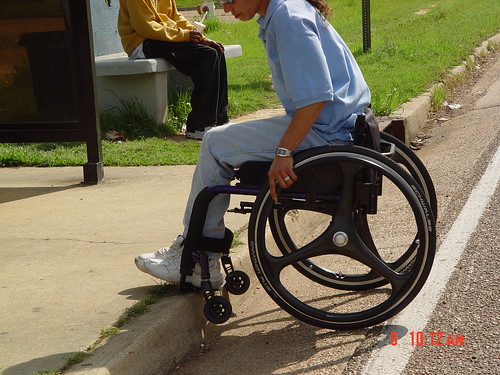20 years after the ADA, continuing the fight to improve access for all
 |
| Sonia at East Beasley Bus Stop 004 Originally uploaded by Transportation for America to Flickr. (Credit to Dr. Scott Crawford) |
| Still working toward accessible and complete streets for all users, 20 years later. |
A couple of years ago, my colleague Stephen Lee Davis profiled Dr. Scott Crawford, a wheelchair user and resident of Jackson, Mississippi who has long fought for accessible buses with wheelchair lifts, curb ramps and better sidewalks.
As Dr. Crawford’s story reminds us, there is still a lot of work to do in making our communities accessible for all users. But he’s had a powerful legal tool in his fight to make Jackson’s streets and transit services equitable and accessible for all users: The Americans with Disabilities Act, which turned 20 years old just this week. President George H. W. Bush signed the ADA in 1990, and his son, George W. Bush, put his signature on the 2008 amendments to the Act, which broadened protections and addressed provisions that had been weakened by the Courts.
The ADA defines a disability as “a physical or mental impairment that substantially limits a major life activity.”
The ADA made reasonable accommodation in workplaces and businesses for people with disabilities the law of the land, ensuring that a disability wouldn’t automatically marginalize anyone. Before it was signed, Americans who were blind, deaf, wheelchair-bound or with chronic injuries or limitations had no legal recourse against inaccessibility. Public and private sector institutions could ignore them as a silent minority — and they often did.
Reasonable accommodation does not mean that every corner of every building can be reached by everyone. It does mean that an employer or government agency must make a concerted effort — through ramps, elevators, doors wide enough for a wheelchair and other resources — to make the workplace accessible for people with disabilities.
Meeting ADA requirements has certainly been a challenge for many communities, especially those with older buildings and smaller economies. Jackson, Mississippi has had the same bus fleet for decades with broken chair lifts and has struggled to find the resources to upgrade. Many transportation departments are more interested in expanding existing roads and broadening access between towns and cities, forgetting what happens within them.
Difficulties aside, many of us are now realizing that the focus on “reasonable accommodations” has actually improved the quality of life for everyone. Older Americans, whether technically disabled or not, face similar challenges with access, have benefited from lifts on public buses. Mothers pushing strollers appreciate new sidewalk ramps.
Beyond mere ADA compliance, everyone is better off with a focus on “Complete Streets,” ensuring that roads accommodate all users regardless of how they get around. Two Mississippi cities, Tupelo and Hernando, recently adopted complete streets policies, and the Michigan State Senate is poised to do the same. Complete streets fit nicely into the universal design approach, which emphasizes the benefits to everyone rather than perpetuating “us” and “them” delineations. The ADA won’t be enough to make our streets truly safe and complete, as Jeff Peel of the League of American Bicyclists pointed out (h/t Streetsblog.net). “…don’t forget, the ADA [doesn’t] require sidewalks — it says that if they are present, they must be made accessible,” he says.
As we celebrate the ADA, it is worth reminding ourselves not to take progress for granted. Progress happens because we pursue the right policies —and the people force our elected officials to listen up. That’s a point worth remembering for everyone who envisions an America with greater transportation options for all.



















